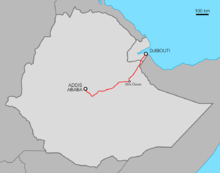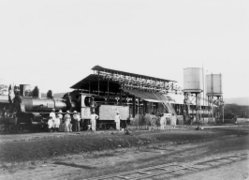- Rail transport in Ethiopia
-
Rail transport in Ethiopia currently consists only of a line from Djibouti to Dire Dawa. The line continues from Dire Dawa to Addis Ababa, but is no longer operational. A new rail network is planned.
Contents
Overview
The Imperial Railway Company of Ethiopia (often referred to by its French name Compagnie Impériale des Chemins de Fer Éthiopiens) was a semi-private firm founded in 1894 to build and operate a railway across eastern Ethiopia from Addis Ababa to the port of Djibouti in what was at the time French Somaliland. The firm failed in 1906 when political discord halted construction, and it failed to obtain any new capital. The portion it had completed ran from Djibouti to the middle of the Ethiopian desert. Its terminus evolved into the city of Dire Dawa.
Discussion of an Ethiopian railway was initiated by Alfred Ilg, an advisor to Emperor Menelek II. He had attempted to interest the previous emperor and other Ethiopian political figures in the construction of a railway to replace the six-week mule trek between the capital and the French port city, but had no success. When Menelek acceded to the throne in 1889, negotiations began anew and a decree was granted on February 11, 1893, to study the construction of rail line. Ilg, a Swiss citizen, and a number of French associates put together a firm and received a royal charter on March 9, 1894, enabling them to start work. Menelek resisted personally putting any funds into the venture, but did grant a 99-year lease to Ilg and his associates in return for a number of shares in the firm and half of all profits in excess of 3,000,000 francs. Furthermore, the firm was obliged to construct a telegraph line along the route.
It took until 1897 before the necessary permission from French authorities was received, by which time significant opposition in Ethiopia had materialised. Elements of the traditional nobility were opposed to the construction, and there were popular demonstrations against it. There was also opposition from the British legation in Addis Ababa, which feared a reduction in traffic to the port of Zeila in British Somaliland.
The firm also had difficulty selling its shares in Europe. Investor interest was restrained, and official interest from the French government was at best lukewarm. All in all, the initial stock offering only earned 8,738,000 francs of the 14 million projected, and an additional offering of 25.5 million francs of bonds yielded only 11 665,000 francs. This was far too little to complete the line. Despite the shortfall, construction began in October 1897 from Djibouti, a hitherto minor port that expanded primarily to serve the railway. A crew of Arab and Somali workers, overseen by Europeans, began to press inland with the line and its associated telegraph. Ethiopians were hired largely as security forces, to prevent the theft of materials on the line. This was also an important source of corruption for the primarily French administration, which fabricated incidents of sabotage and requested funds to buy off local chiefs that it claimed were responsible for it. Furthermore, the line was forced to avoid interfering with local communities and water sources, pushing it out into the desert. This meant that the railway company had to build aqueducts, an additional unplanned expense, to serve the line.
Even before reaching the Ethiopian border, it was clear the firm had serious financial problems. A group of British investors calling themselves the New Africa Company effectively took control of the firm over several years. They provided a new source of capital, and by 1901 had joined with the French investors to form the International Ethiopian Railway Trust and Construction Company - a holding firm which essentially controlled the railway and supplied it with further capital. The first commercial service began in July 1901, from Djibouti to Dire Dawa.
This mixture of French and British interests proved volatile, as each group of investors stood increasingly for both national and commercial interests. Both governments became interested in monopolising Ethiopian trade and conspired to force the other into a minor position. The demands and threats of the two governments led Emperor Menelek in 1902 to forbid the expansion of the railway line to Harar. French negotiations to resume work were blocked by Menelek's growing suspicion of French motives, and the line could not earn enough to pay back the company's debts with such a limited service. The signature of the Entente Cordiale in 1904 reopened the possibility of continued joint Anglo-French investment and development, but there was enough resistance to such proposals on both sides that no progress was made. The firm went formally bankrupt in 1906.
Reconstruction
In 1908, the assets of the company were transferred to a new firm, the Compagnie de Chemin de Fer Franco-Ethiopien de Jibuti à Addis Abeba, which received a new concession to finish the line to Addis Ababa. After a year of wrangling with the previous financiers and their governments, construction began anew. By 1915 the line reached Akaki, only 23 kilometers from the capital, and two years later came all the way to Addis Ababa itself.
Ethiopia's share in the railway was seized by the Italian government in the Second Italo-Abyssinian War, but was regained by Ethiopia after the Second World War. Following the independence of Djibouti in 1977, the French share in the railway was transferred to the new nation.
Post-War history
Workers for the Railway were pioneers in the Ethiopian labor movement. They organized one of the first labor unions in Ethiopia in 1947, the Railroad Workers Syndicate of Dire Dawa, for mutual welfare purposes.[1] Although its leadership co-operated with the Government, an attempted strike in 1949 was brutally suppressed by government troops; at the time, all strikes were seen by government officials as a form of insurrection.[2]
The railway company carried out surveys for extending its line 310 kilometers south from Adama to Dilla between 1960 and 1963. The government formed a Nazareth-Dilla Railway Development Corporation to support this new branch. Although the French government offered a loan to fund this new branch in 1965, and Yugoslav experts had studied and thought the project would be worthwhile, this project was never carried out.[3]
After the independence of Djibouti (1977), France transferred its ownership to the government of Djibouti for the now newly formed Ethio-Djibouti Railways (about 1982).
In 2003 the European Commission prepared a grant of EUR 40 million for the rehabilitation of the Djibouti-Ethiopia Railway. Reflecting increases in fuel and steel prices, the commission has increased this grant to EUR 50m in 2006. The Djiboutian Ministry of Equipment and Transport and the Ethiopian Ministry of Transportation and Communications chose the South African firm Comazar to administer the railway in March, 2006. A 25-year concession was due to be signed in June 2007, but this failed to happen, and negotiations began with Kuwaiti company Fouad Alghanim and Sons Group.[4]
The new management was expected to raise the capacity of the railroad from its current average of 240,000 tons to 1.5 million tons.[5]
The governments of Djibouti and Ethiopia signed an agreement with the Italian consortium Costra 29 November 2006; work will begin early 2007 on sections of the line that deteriorated following the Ogaden War.[6] The gauge of the line is 1,000 mm (3 ft 3 3⁄8 in).
New network
In January 2010, it was announced that the Ethiopian government had signed a memorandum of understanding with four companies, the China Communications Construction, China Railway Engineering Corporation, and an Indian and Russian company.[7] After all parties except the Chinese firms failed to take further action, the contract was awarded to the CRCG. In August, funding for the project was agreed to come from the Export and Import Bank of China. In September 2010, construction began on the project.
The new network will be 5,000 km long, and radiate from the capital, Addis Ababa. The system will be constructed in two phases, the first phase involving the construction of five lines.[8] The project will provide 300,000 jobs in construction and cost $336 million annually for five years. The system will handle 6 million tonnes of freight.
The gauge of the new railway will be 1,435 mm (4 ft 8 1⁄2 in) as there is no point in increasing the size of the network four fold on a obsolete gauge, and also standard gauge proposed changes in adjacent countries.
Also included was a light rail system in Addis Ababa.
Railway links to adjacent countries
 Djibouti - yes - 1,000 mm (3 ft 3 3⁄8 in)
Djibouti - yes - 1,000 mm (3 ft 3 3⁄8 in) Kenya - no break-of-gauge 1,000 mm (3 ft 3 3⁄8 in)
Kenya - no break-of-gauge 1,000 mm (3 ft 3 3⁄8 in) Eritrea - break-of-gauge 1,000 mm (3 ft 3 3⁄8 in)/950 mm (3 ft 1 3⁄8 in)
Eritrea - break-of-gauge 1,000 mm (3 ft 3 3⁄8 in)/950 mm (3 ft 1 3⁄8 in) Somalia - no railways
Somalia - no railways Sudan - break-of-gauge 1,000 mm (3 ft 3 3⁄8 in)/1,067 mm (3 ft 6 in)
Sudan - break-of-gauge 1,000 mm (3 ft 3 3⁄8 in)/1,067 mm (3 ft 6 in)
See also
Notes
- ^ "Local History in Ethiopia" (pdf) The Nordic Africa Institute website (accessed 1 March 2008)
- ^ Edmund J. Keller, Revolutionary Ethiopia (Bloomington: Indiana University Press, 1988), p. 147
- ^ "Dil Amba - Djibiet" (pdf). Local History in Ethiopia. The Nordic Africa Institute. 2005. http://130.238.24.99/library/resources/dossiers/local_history_of_ethiopia/d/ORTDIL05.pdf. Retrieved 2011-09-20.. The route of this proposed extension is shown on the map accompanying the article by Nathaniel T. Kenney, "Ethiopian Adventure", National Geographic, 127 (1965).
- ^ "No concession at Ethio-Djibouti Railway" Railway Gazette International September 2007
- ^ South African firm wins bid to administer Ethio-Djibouti railway Hiiran Online
- ^ "Ethio-Djibouti Railway rehabilitation accord signed" Walta Information Center
- ^ http://allafrica.com/stories/201001190639.html
- ^ http://www.sudantribune.com/spip.php?article36391
External links
Further reading
- Tom C. Killion, "Railroad Workers and the Ethiopian Imperial State: The Politics of Workers' Organization on the Franco-Ethiopian Railroad, 1919-1959", The International Journal of African Historical Studies, 25 (1992), pp. 583–605.
Rail transport in Africa Sovereign
states- Algeria
- Angola
- Benin
- Botswana
- Burkina Faso
- Burundi
- Cameroon
- Cape Verde
- Central African Republic
- Chad
- Comoros
- Democratic Republic of the Congo
- Republic of the Congo
- Côte d'Ivoire (Ivory Coast)
- Djibouti
- Egypt
- Equatorial Guinea
- Eritrea
- Ethiopia
- Gabon
- The Gambia
- Ghana
- Guinea
- Guinea-Bissau
- Kenya
- Lesotho
- Liberia
- Libya
- Madagascar
- Malawi
- Mali
- Mauritania
- Mauritius
- Morocco
- Mozambique
- Namibia
- Niger
- Nigeria
- Rwanda
- São Tomé and Príncipe
- Senegal
- Seychelles
- Sierra Leone
- Somalia
- South Africa
- South Sudan
- Sudan
- Swaziland
- Tanzania
- Togo
- Tunisia
- Uganda
- Zambia
- Zimbabwe
States with limited
recognition- Sahrawi Arab Democratic Republic
- Somaliland
Dependencies and
other territories- Canary Islands / Ceuta / Melilla / Plazas de soberanía (Spain)
- Madeira (Portugal)
- Mayotte / Réunion (France)
- Saint Helena / Ascension Island / Tristan da Cunha (United Kingdom)
- Western Sahara
Categories:- Rail transport in Ethiopia
- Railway companies
- Companies of Ethiopia
Wikimedia Foundation. 2010.



